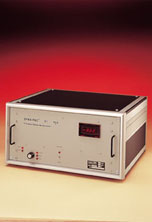 Trace Moisture Gas Generators:Span Pac™ general informationSpan Pac™ 61-H2O and 261-H2O  Span Pac™ 61-W-H2O and 261-W-H2O  Span Pac™ 61-W-H2O-SD  Reactive Gases Model  Industrial-grade Models  |
Trace Moisture Gas Standards Generators Trace concentration moisture is an extremely important parameter in gases used in a wide range of processes. But there is no absolute analytical method that can be used in all applications. For most sensing methods, the response to moisture is affected by the background gas and most current methods are subject to "poisoning" by certain contaminants. Basically, all trace moisture sensing systems require calibration to external standards and they must be frequently challenged with standards to demonstrate continued accuracy. Span Pac H20 Instrument Series - Trace Moisture Gas Standards
There are three special problems associated with trace moisture calibration:
The Span PacT H2O systems work on a differential principal. Calibration is based on the change in analyzer response caused by the addition of a known water vapor concentration from a Trace SourceT H20 permeation tube to a flowing stream of background gas (which may also contain some moisture). This differential method overcomes the "no zero" problem, and the problem of the background gas affecting the response. Water vapor flow from the permeation tube is measured gravimetrically, and is traceable to NIST. This technique provides a close approximation to a primary standard, even in situations where primary standards are not available. Special care in design, construction and choice of components minimizes errors due to atmospheric contamination and interactions with other materials in the system. As listed in menu, several Span PacT H2O models are offered to insure an economical solution to every moisture calibration problem. |




